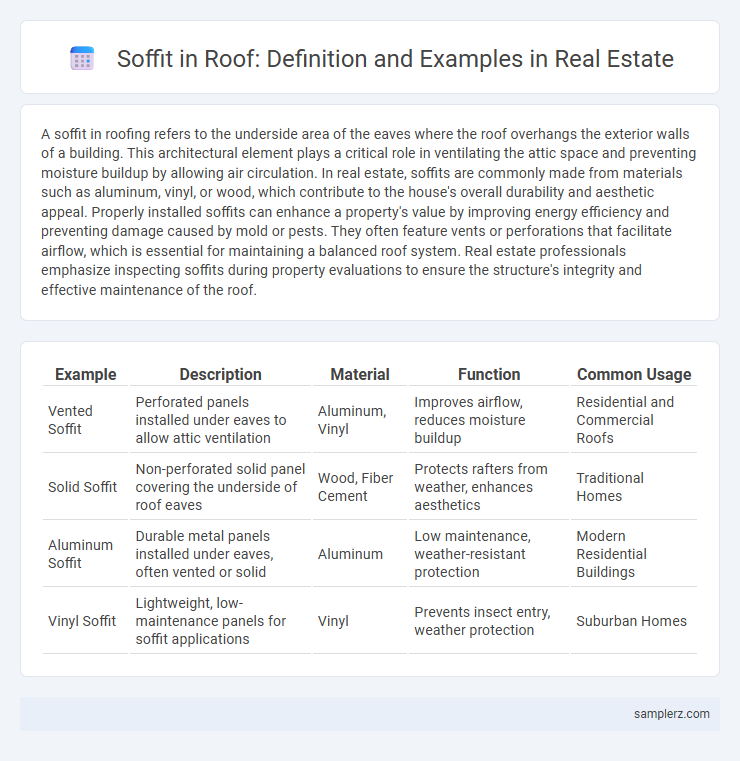A soffit in roofing refers to the underside area of the eaves where the roof overhangs the exterior walls of a building. This architectural element plays a critical role in ventilating the attic space and preventing moisture buildup by allowing air circulation. In real estate, soffits are commonly made from materials such as aluminum, vinyl, or wood, which contribute to the house's overall durability and aesthetic appeal. Properly installed soffits can enhance a property's value by improving energy efficiency and preventing damage caused by mold or pests. They often feature vents or perforations that facilitate airflow, which is essential for maintaining a balanced roof system. Real estate professionals emphasize inspecting soffits during property evaluations to ensure the structure's integrity and effective maintenance of the roof.
Table of Comparison
| Example | Description | Material | Function | Common Usage |
|---|---|---|---|---|
| Vented Soffit | Perforated panels installed under eaves to allow attic ventilation | Aluminum, Vinyl | Improves airflow, reduces moisture buildup | Residential and Commercial Roofs |
| Solid Soffit | Non-perforated solid panel covering the underside of roof eaves | Wood, Fiber Cement | Protects rafters from weather, enhances aesthetics | Traditional Homes |
| Aluminum Soffit | Durable metal panels installed under eaves, often vented or solid | Aluminum | Low maintenance, weather-resistant protection | Modern Residential Buildings |
| Vinyl Soffit | Lightweight, low-maintenance panels for soffit applications | Vinyl | Prevents insect entry, weather protection | Suburban Homes |
Understanding Roof Soffits: Definition and Purpose
A roof soffit is the horizontal underside of an eave, connecting the roof's edge to the exterior wall. It provides ventilation to the attic, preventing moisture buildup and promoting airflow, which protects the roofing structure from damage. Soffits also enhance the aesthetic appeal of a property by concealing rafters and other structural elements.
Common Materials Used for Roof Soffits
Common materials used for roof soffits include vinyl, aluminum, and wood, each offering unique benefits in durability and aesthetics. Vinyl soffits are popular due to their resistance to moisture and low maintenance requirements, making them ideal for various climates. Aluminum soffits provide excellent ventilation and corrosion resistance, while wood soffits offer a traditional look but require regular upkeep to prevent rot and insect damage.
Soffit Design Examples in Modern Homes
Soffit design in modern homes often features sleek, vented aluminum or fiber cement materials to enhance ventilation and aesthetic appeal. Common examples include continuous soffits with integrated LED lighting that provide both functional airflow and contemporary style. These designs emphasize clean lines and seamless transitions between roof edges and exterior walls, contributing to the overall modern architectural look.
Functional Benefits of Roof Soffits
Roof soffits provide essential ventilation, preventing moisture buildup and reducing the risk of mold and wood rot in attic spaces. By allowing airflow beneath the roof overhang, soffits help regulate temperature and improve energy efficiency in homes. These functional benefits contribute to the overall durability and maintenance of a property's roofing system.
Soffit Installation Techniques: A Brief Overview
Soffit installation techniques in roofing involve attaching ventilation panels beneath the roof eaves to enhance airflow and prevent moisture buildup. Common materials for soffits include vinyl, aluminum, and wood, each requiring proper sealing and fastening to withstand weather conditions. Effective soffit installation improves attic ventilation, reducing the risk of mold and prolonging roof lifespan.
Popular Soffit Ventilation Options for Better Airflow
Popular soffit ventilation options for better airflow include continuous soffit vents, typically made from aluminum or vinyl, which provide effective intake ventilation by allowing air to flow freely along the eaves. Vented soffit panels, featuring perforated designs, enhance attic ventilation while preventing moisture buildup and reducing the risk of mold growth. These options, combined with ridge vents, create a balanced airflow system critical for maintaining optimal roof temperature and prolonging the roof's lifespan.
Comparing Soffit Styles: Flat vs. Vented Examples
Flat soffits offer a sleek, modern look that complements contemporary roof designs while providing a smooth surface for easy maintenance. Vented soffits, commonly used in traditional homes, enhance attic ventilation by allowing air circulation, which helps prevent moisture buildup and extends roof longevity. Choosing between flat and vented soffits depends on aesthetic preference and the specific ventilation needs of the roofing system.
Enhancing Curb Appeal with Decorative Soffits
Decorative soffits, installed under the eaves of a roof, significantly enhance curb appeal by adding architectural interest and a polished finish to the home's exterior. Materials such as vinyl, aluminum, or wood can be customized with intricate designs or ventilation features that improve both aesthetics and functionality. Well-crafted soffits also protect the roof structure from moisture and pests, increasing the property's value and durability.
Maintenance Tips for Roof Soffits in Real Estate
Regular inspection of roof soffits is crucial to prevent water damage and pest infiltration, key concerns in real estate maintenance. Cleaning soffit vents ensures proper attic ventilation, reducing moisture buildup and prolonging roof lifespan. Applying weather-resistant paint and sealing gaps minimizes deterioration and enhances the property's curb appeal.
How Soffits Impact Property Value in Real Estate
Soffits play a crucial role in enhancing a property's curb appeal and protecting the roof structure from moisture and pests, which can prevent costly damage and maintenance issues. Well-maintained soffits improve ventilation in the attic, reducing energy costs and increasing the home's overall efficiency. Real estate appraisers often view quality soffit installation as a sign of a well-cared-for property, positively impacting market value and buyer interest.

example of soffit in roof Infographic
 samplerz.com
samplerz.com